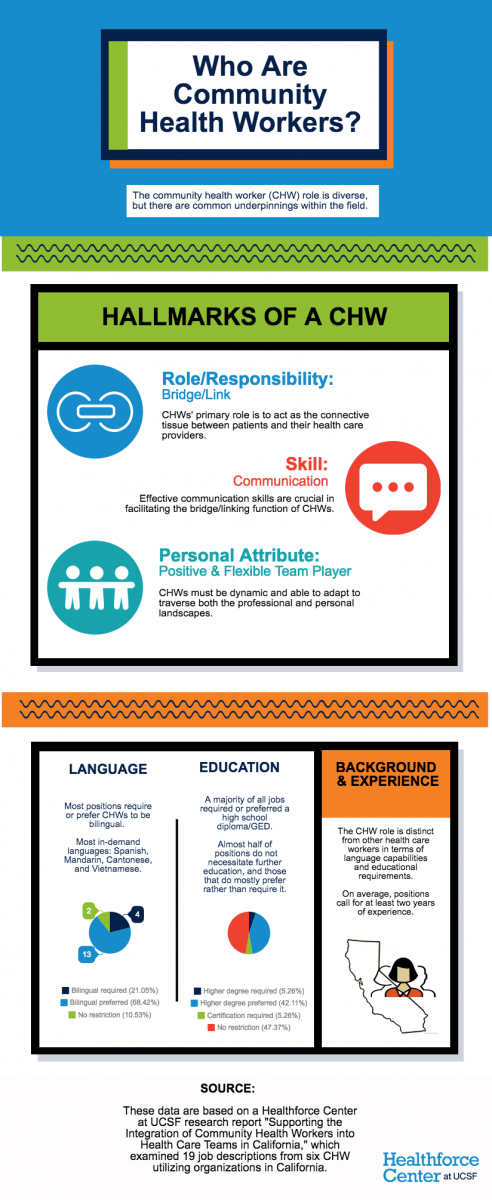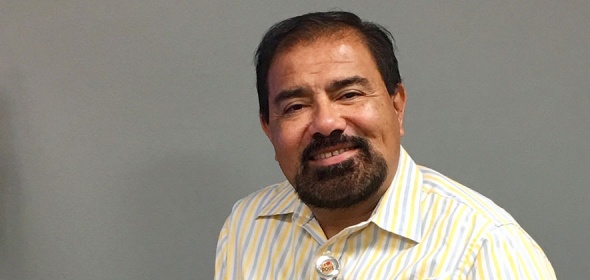By Jackie Miller
As a community health worker (CHW) at Care Connections Program in Los Angeles County, Walfred Lopez acts as a liaison between patients and medical professionals to help people find resources and overcome challenges related to chronic conditions. He’s part of a growing movement of CHWs who joined together on June 19 for Healthforce Center at UCSF’s event that introduced Walfred to a broader picture of the CHW landscape.
“It’s a complete movement, and there are a lot of people involved. I can see the bigger picture now,” he said.
Healthforce Center researchers brought CHWs and stakeholders together to discuss CHWs’ past, present and future. The convening culminated a year-and-a-half long, Blue Shield of California Foundation funded project that evaluated the CHW workforce.
The two preceding elements of the project include a policy brief that provides background about the CHW role and a research report that describes site visit findings from six organizations utilizing CHWs.
Attendees included CHWs, organizational leaders and champions, people involved with CHW education/training, CHW policy and legislation representatives, and people from surrounding counties with budding or soon-to-be budding programs.
Working in the field of community health for over 20 years, Walfred has held a variety of positions. He has done HIV outreach; served as a medical assistant; administered retinal scans and education for diabetic patients; and helped patients get insurance through Covered California. He started at Care Connections in 2015 at the program’s inception and is one of the three original CHWs hired into the program. Recently, he visited a patient who refused dialysis and was near death. Upon discovering that she was hiding her medication, he spoke with all members of the family and ultimately convinced her to try dialysis.
Although she initially resisted his assistance, the woman now recognizes that Walfred saved her life. “Now she loves me and I am part of the family again. To see that lady alive, and her kids coming to say ‘without what you did, we wouldn’t have her today’ — that made my week.”
At the convening, Walfred learned about programs and policies at the state level that could impact the CHW workforce. California’s Alternative Payment Methodology Pilot, for example, provides participating, federally qualified health centers the flexibility to deliver care in the most effective manner, without having to worry about the more restrictive, traditional billing structure that is in place today.
In addition, California Assembly Bill 391 would require the Department of Health Care Services (DHCS) to develop and submit a state plan amendment to permit Medi-Cal fee-for-service to cover and pay for certain asthma services. This would allow CHWs / Promotoras to provide asthma education and home environmental asthma trigger assessment services through Medi-Cal. Walfred hopes the CHW workforce will get organized and create a board of directors or a similar body of leadership to tackle some of the CHW workforce issues.
This board would act as a “central brain — where all ideas and energy can come, [where we can] bring thoughts and ideas together to talk about [the CHW role],” Walfred said. From his perspective, such a group of people would ideally include a balanced mix of CHWs, CHW leadership, investors/funders and other stakeholders.
One of the biggest challenges facing the CHW role surrounds the uncertainty of funding; many positions are funded by grants, which often have definitive end dates. This can be a devastating blow to CHWs individually, as well as communities at large. Walfred envisions a world with better job security, perhaps mitigated by utilizing CHW funding dollars to equip CHWs with other professional skills to provide them with back-up vocations in the event that CHW funding dwindles.
“We have the heart – there is no question about it – to be a CHW, you have to have the heart. But, we also need the job.”
Learn more about community health workers in this infographic:

Join Us
Sign up to get updates on health workforce research insights, trends and leadership opportunities.
About Jackie
Jackie Miller is a research analyst with the Institute for Health Policy Studies and Healthforce Center. Her projects vary in scope; some are limited to California, such as the CHW project, while others look across state boarders to analyze workforce policies and workforce supply and demand.
